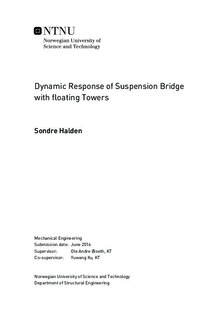Dynamic Response of Suspension Bridge with floating Towers
Master thesis
Permanent lenke
http://hdl.handle.net/11250/2407314Utgivelsesdato
2016Metadata
Vis full innførselSamlinger
Sammendrag
The Norwegian Public Road Administration has been investigating the possibilities of crossing the fjords on the west coast of Norway for the coastal highway E39 project. For the 5 km wide Bjørnafjorden a floating three span suspension bridge with two pylons standing on tension leg platforms (TLP), is considered. A parametrized model of a floating multi-span TLP suspension bridge has been created, where the parameters have been given the planned geometry of the Bjørnafjorden bridge concept. A hydrodynamic analysis conducted on a FE-model of a pontoon where added mass, damping, restoring forces and the wave transfer function were obtained. Buffeting theory and aerodynamic derivatives were used to obtain the buffeting forces, stiffness and damping terms. A generalized method was developed to couple system matrices and forces from wind and waves in modal coordinates.
Modal-, response- and motion induced instability analyses, all accounting for hydrodynamic added mass, damping and restoring forces and aerodynamic damping and stiffness, have been conducted in the frequency domain. The environmental effects resulted in significantly lower eigenfrequencies. A response analysis was carried out for combinations of different stationary parameters for wind and waves. It was evident that wind governed the response in transversal- and waves for the vertical and rotational directions for modes with higher corresponding eigenfrequenciees. The most participating modes was the first mode in transversal direction and the first mode in vertical direction, obtained from the modal analysis, frequency response spectra and standard deviations. An aerodynamic motion induced instability limit was found to de 88 m/s at 1.5217 rad/s.
